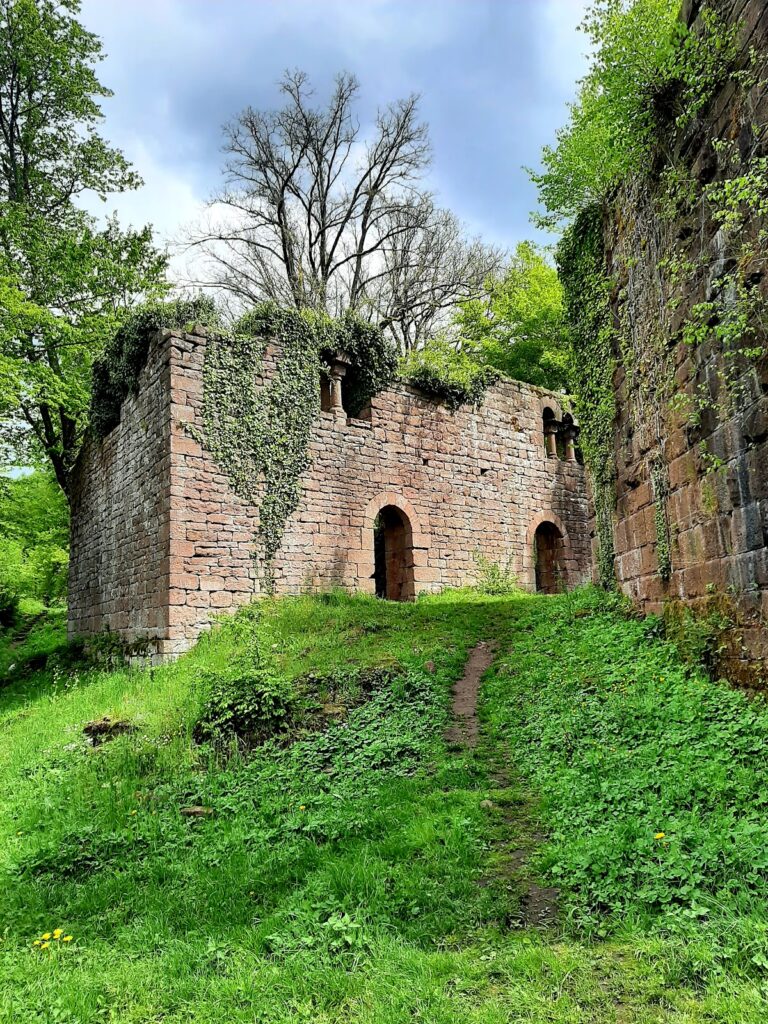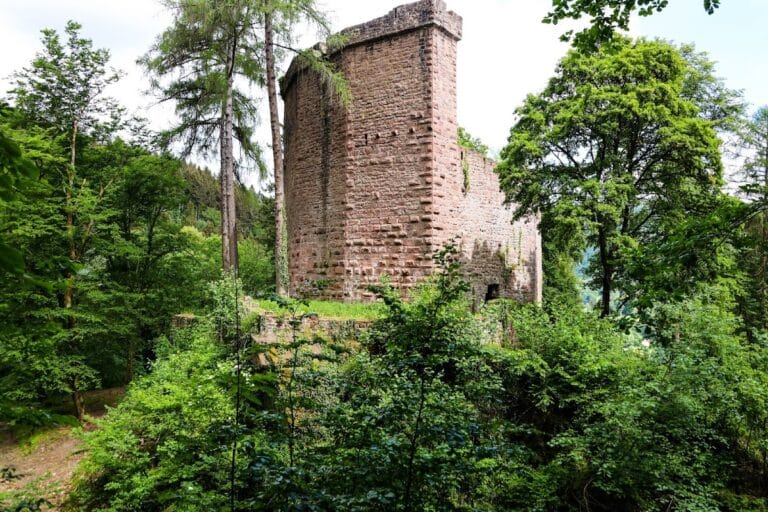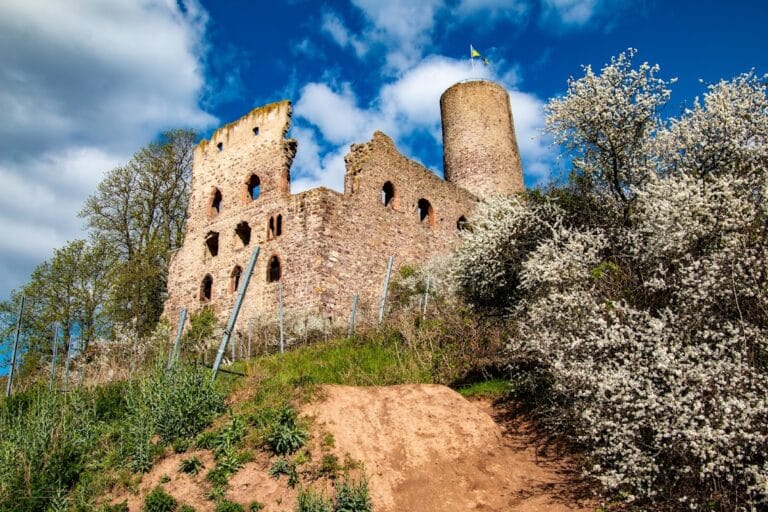Hirschhorn Castle: A Historic Fortress in Germany
Visitor Information
Google Rating: 4.6
Popularity: Low
Google Maps: View on Google Maps
Official Website: www.hirschhorn.de
Country: Germany
Civilization: Medieval European
Remains: Military
History
Hirschhorn Castle is located in the town of Hirschhorn in present-day Germany. It was established in the mid-13th century by a noble family that lent its name to the site and became known as the von Hirschhorn family.
The origins of the castle trace back to around 1260 when Johann von Hirschhorn built the fortress. Johann was likely descended from a union between the noble von Steinach family and the ministerial von Hirschberg family. The distinctive Hirschhorn family coat of arms, featuring deer antlers, originated from the von Hirschberg lineage. Some scholars propose an earlier founding around 1250 by Konrad von Steinach, Johann’s father, but archaeological research has not uncovered evidence for fortifications before Johann’s time. From its inception, the castle’s position high on a southern spur overlooking the Neckar valley allowed its owners to oversee important trade routes along the Neckar River and its tributaries, the Finkenbach and Ulfenbach valleys. This strategic control helped the family secure considerable wealth and political influence during the 14th century.
The Hirschhorn family maintained ownership of the castle for almost 400 years until 1632. Five generations after Johann, around 1400, Hans V von Hirschhorn established a Carmelite monastery close to the castle, dedicated to the Virgin Mary. This monastery was itself fortified, reflecting the turbulent era and the importance of religious institutions in the region. Following the Hirschhorn tenure, the castle passed through the hands of the Reitz von Frentz and von der Recke families until the end of the 17th century.
In 1699, the castle became the official residence of the Elector of Mainz, a powerful ecclesiastical prince within the Holy Roman Empire, until 1803. Afterward, it was held by the Grand Dukes of Hesse-Darmstadt until the monarchy’s fall in 1918. Throughout these centuries, the castle was enlarged and remodeled multiple times, culminating in its Renaissance style during the late 16th century, which gave it much of its present form. Despite being located in a region affected by frequent conflicts, Hirschhorn Castle avoided destruction, remaining remarkably intact.
Following the end of the Grand Duchy, the property transferred to the People’s State of Hesse and, after World War II, to the Federal State of Hesse. In the modern era, parts of the castle have found new uses while preserving its historical legacy, a continuation of its longstanding significance in the region.
Remains
Hirschhorn Castle occupies a commanding position on a rocky spur above the town, utilizing the natural high ground to its defensive advantage. The site is a well-preserved example of a spur castle, constructed mainly of sandstone and spread across three primary sections: the central stronghold known as the main castle or citadel, the upper outer bailey called Oberhof, and the lower outer bailey known as Unterhof. These three autonomous areas form a cohesive complex that illustrates the castle’s development over centuries.
At the heart of the castle on the summit lies the oldest component. A robust shield wall faces north, designed to defend the castle’s most vulnerable approach. This wall is complemented by a deep defensive ditch cut directly into the rock, originally part of the fortification system and measuring up to 15 meters deep. Today, this ditch serves a different purpose but remains a striking feature reflecting the defensive ingenuity of medieval builders. Within the main castle stands the Palas, or residential palace, first erected in the early 14th century and rebuilt later that century. Restorations in the early 19th century followed a partial collapse. Attached to the Palas is a tall bergfried, a type of main tower typical of medieval fortifications, measuring about 26 meters high. This tower carries an appearance shaped by Renaissance renovations from the late 1500s.
Southwest of the main castle lies the upper outer bailey, constructed in the 15th century on the site where an earlier 14th-century enclosure once stood. The bailey features a large bastion that guarded the northern entrance, a western round tower known as the Prison Tower where detainees were held, and a well providing water. The courtyard within this outer bailey was once lively with storage buildings, stables, and dwellings, though many of these have since been removed, leaving a spacious open area.
Further down the slope to the south, separated by a stone wall with a two-story gatehouse, is the lower outer bailey. This area contains surviving stables and various service buildings critical to the castle’s day-to-day operation. One of its defensive towers integrates directly into the adjacent town’s city walls, demonstrating the architectural connection between the castle and the urban defenses of Hirschhorn.
The castle’s fortification system, including the outer baileys and the town walls, was likely developed under the guidance of Hans V von Hirschhorn in the late 14th century, with construction completing in the early 15th century. Enhancements in the late 1500s added the Renaissance-style Hatzfeldbau wing, named after Maria von Hatzfeld, the wife of Ludwig I von Hirschhorn. This addition enriched the castle’s residential quarters and included gardens and terraces overlooking the Neckar River.
Within the complex, a small gatekeeper’s house near the center is noted for its distinctive design. Architectural elements throughout the castle show a blend of Romanesque and Gothic features, visible in window styles and frescoes preserved in the chapel. These frescoes depict scenes from the Passion of Christ, revealing the importance of religious art within the castle’s spiritual life.
Overall, the castle grounds, including the inner courtyard and the bergfried, remain largely intact and provide a remarkable glimpse into centuries of architectural evolution and noble life along the Neckar valley.










